Communication Skills: Types, Significance, and Workplace Impact
VerifiedAdded on 2020/06/03
|12
|2787
|136
Report
AI Summary
This report provides a comprehensive overview of communication skills in the workplace. It begins by defining communication skills and highlighting their effectiveness and significance in a business environment. The report then explores various types of communication channels, including formal and informal communication, interpersonal communication (oral, written, and non-verbal), and different communication structures (vertical, horizontal, chain, circle, star, and all-channel). It also discusses strategies for improving clarity of expression, grammar, syntax, and punctuation. The report emphasizes the importance of good communication skills for both higher authority and subordinates in achieving organizational success. It concludes that effective communication is crucial for organizational success and individual career advancement, covering both public and private sectors. This report is a valuable resource for students seeking to understand and improve their communication skills.
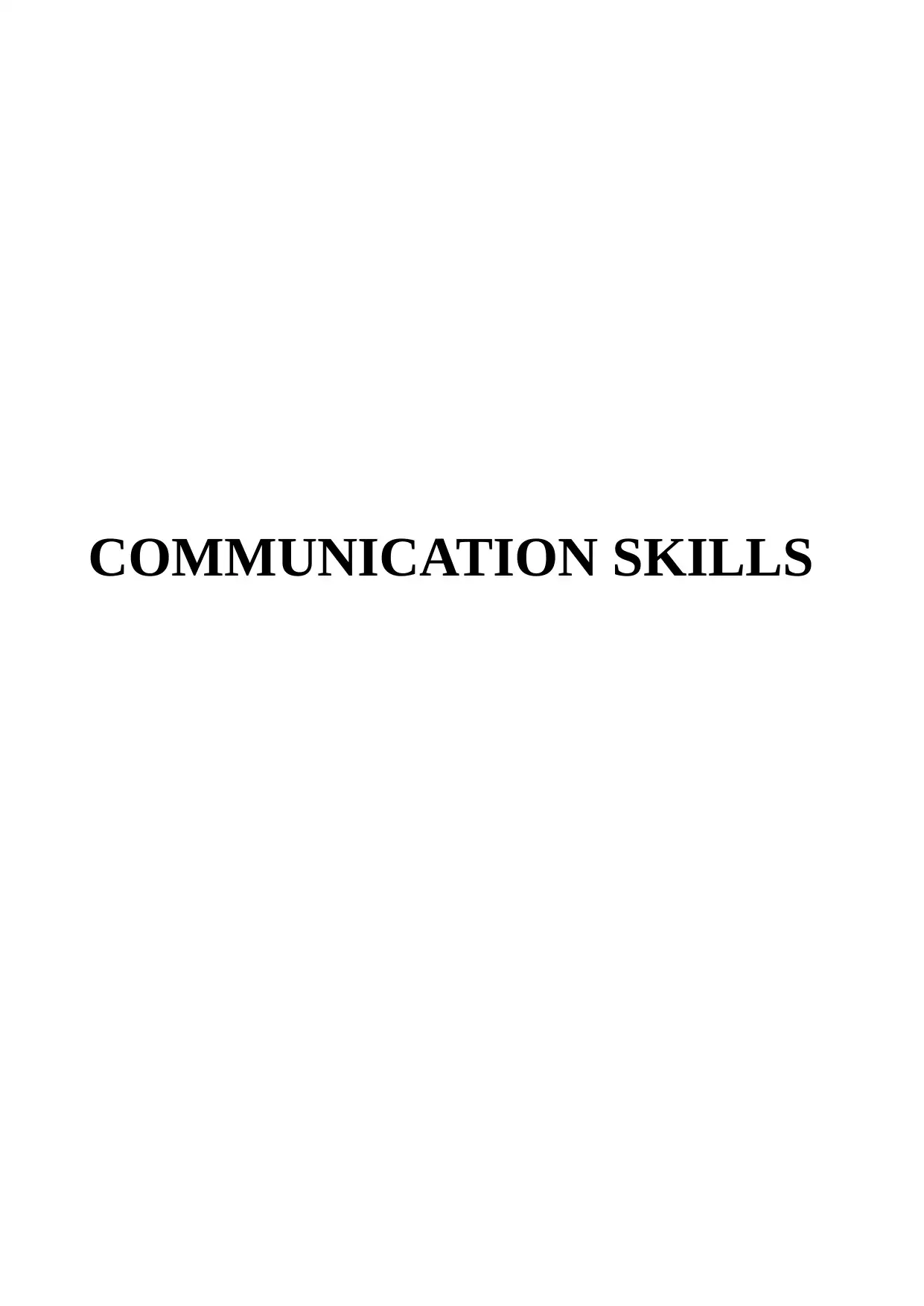
COMMUNICATION SKILLS
Paraphrase This Document
Need a fresh take? Get an instant paraphrase of this document with our AI Paraphraser
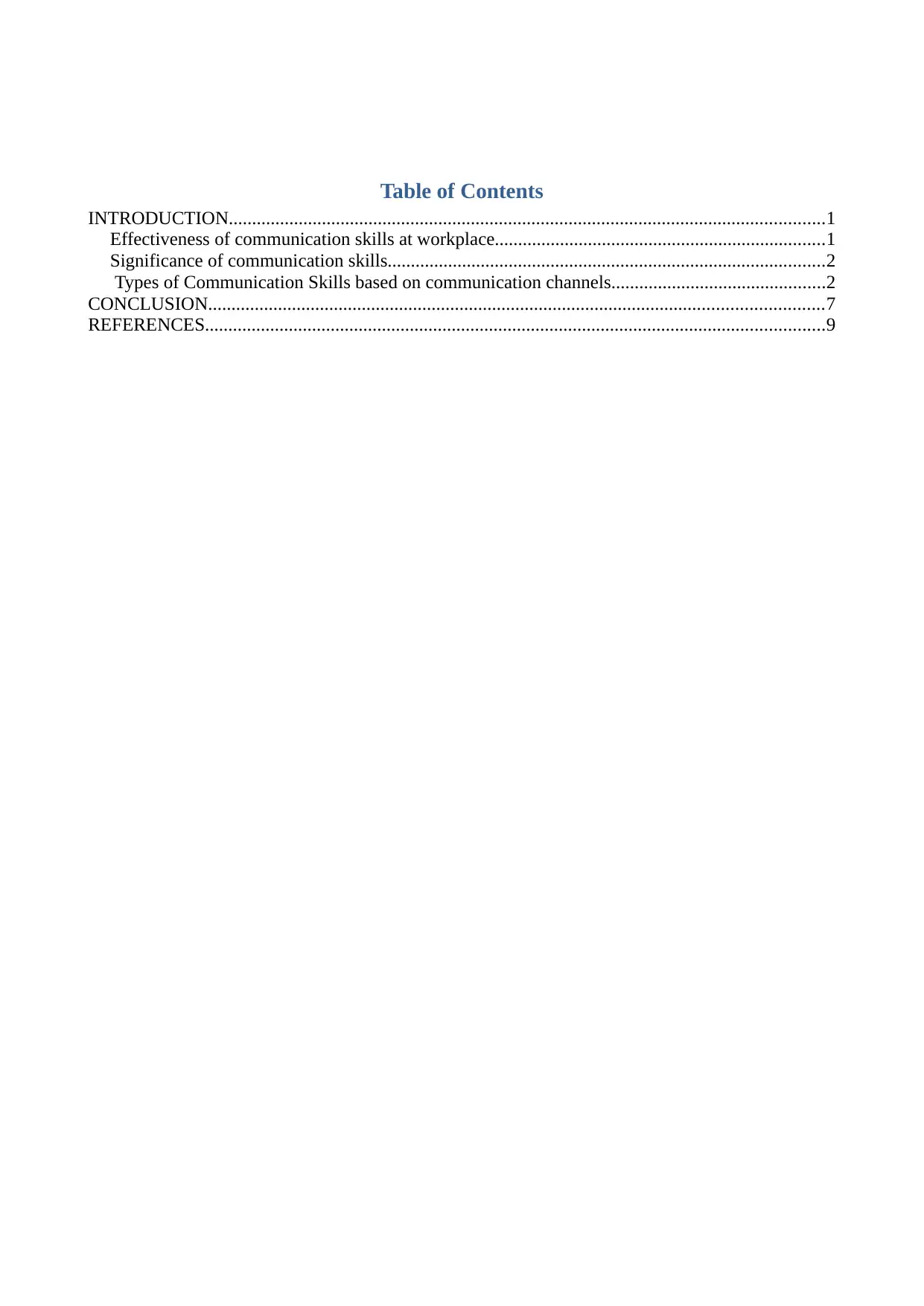
Table of Contents
INTRODUCTION................................................................................................................................1
Effectiveness of communication skills at workplace.......................................................................1
Significance of communication skills..............................................................................................2
Types of Communication Skills based on communication channels..............................................2
CONCLUSION....................................................................................................................................7
REFERENCES.....................................................................................................................................9
INTRODUCTION................................................................................................................................1
Effectiveness of communication skills at workplace.......................................................................1
Significance of communication skills..............................................................................................2
Types of Communication Skills based on communication channels..............................................2
CONCLUSION....................................................................................................................................7
REFERENCES.....................................................................................................................................9
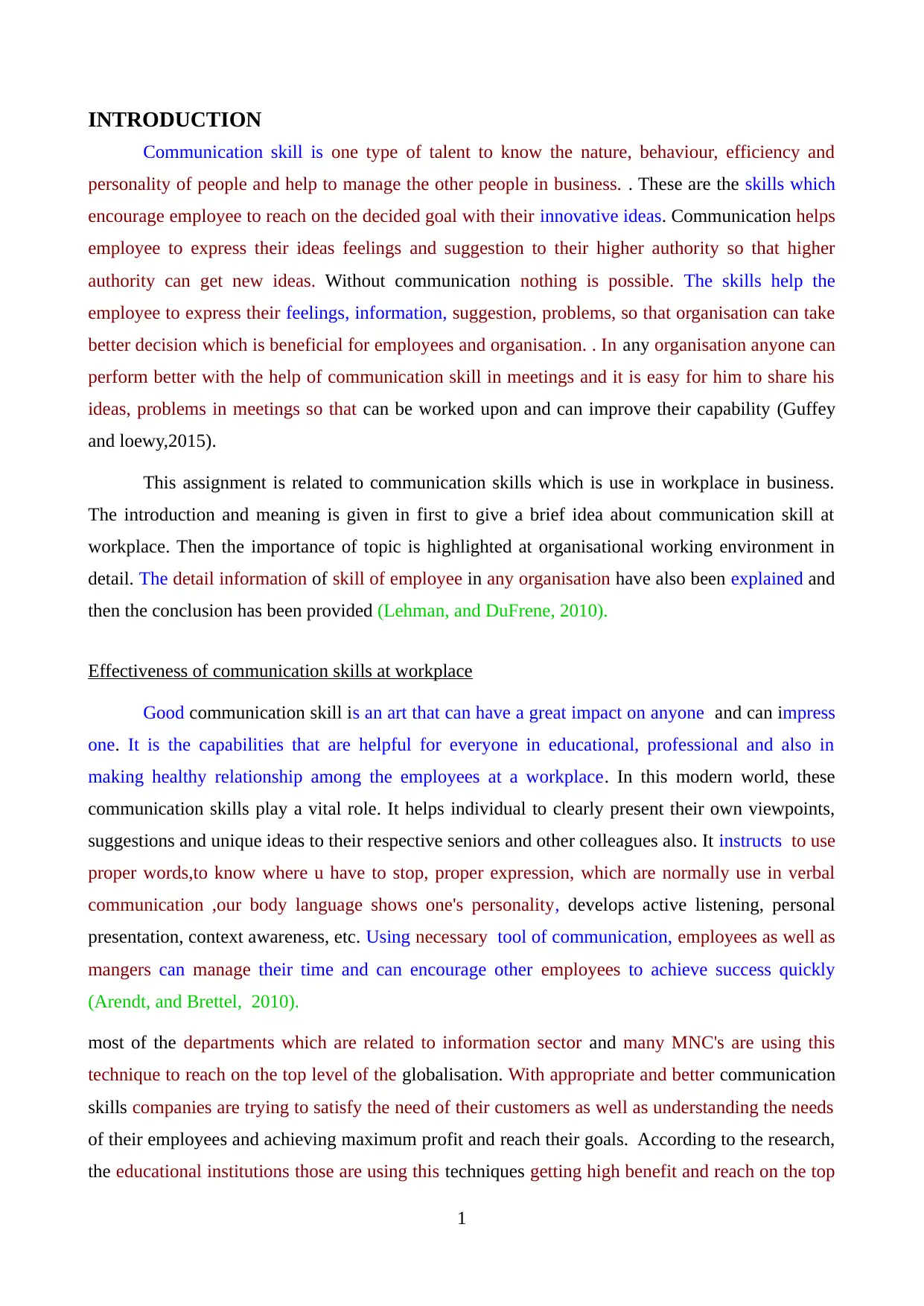
INTRODUCTION
Communication skill is one type of talent to know the nature, behaviour, efficiency and
personality of people and help to manage the other people in business. . These are the skills which
encourage employee to reach on the decided goal with their innovative ideas. Communication helps
employee to express their ideas feelings and suggestion to their higher authority so that higher
authority can get new ideas. Without communication nothing is possible. The skills help the
employee to express their feelings, information, suggestion, problems, so that organisation can take
better decision which is beneficial for employees and organisation. . In any organisation anyone can
perform better with the help of communication skill in meetings and it is easy for him to share his
ideas, problems in meetings so that can be worked upon and can improve their capability (Guffey
and loewy,2015).
This assignment is related to communication skills which is use in workplace in business.
The introduction and meaning is given in first to give a brief idea about communication skill at
workplace. Then the importance of topic is highlighted at organisational working environment in
detail. The detail information of skill of employee in any organisation have also been explained and
then the conclusion has been provided (Lehman, and DuFrene, 2010).
Effectiveness of communication skills at workplace
Good communication skill is an art that can have a great impact on anyone and can impress
one. It is the capabilities that are helpful for everyone in educational, professional and also in
making healthy relationship among the employees at a workplace. In this modern world, these
communication skills play a vital role. It helps individual to clearly present their own viewpoints,
suggestions and unique ideas to their respective seniors and other colleagues also. It instructs to use
proper words,to know where u have to stop, proper expression, which are normally use in verbal
communication ,our body language shows one's personality, develops active listening, personal
presentation, context awareness, etc. Using necessary tool of communication, employees as well as
mangers can manage their time and can encourage other employees to achieve success quickly
(Arendt, and Brettel, 2010).
most of the departments which are related to information sector and many MNC's are using this
technique to reach on the top level of the globalisation. With appropriate and better communication
skills companies are trying to satisfy the need of their customers as well as understanding the needs
of their employees and achieving maximum profit and reach their goals. According to the research,
the educational institutions those are using this techniques getting high benefit and reach on the top
1
Communication skill is one type of talent to know the nature, behaviour, efficiency and
personality of people and help to manage the other people in business. . These are the skills which
encourage employee to reach on the decided goal with their innovative ideas. Communication helps
employee to express their ideas feelings and suggestion to their higher authority so that higher
authority can get new ideas. Without communication nothing is possible. The skills help the
employee to express their feelings, information, suggestion, problems, so that organisation can take
better decision which is beneficial for employees and organisation. . In any organisation anyone can
perform better with the help of communication skill in meetings and it is easy for him to share his
ideas, problems in meetings so that can be worked upon and can improve their capability (Guffey
and loewy,2015).
This assignment is related to communication skills which is use in workplace in business.
The introduction and meaning is given in first to give a brief idea about communication skill at
workplace. Then the importance of topic is highlighted at organisational working environment in
detail. The detail information of skill of employee in any organisation have also been explained and
then the conclusion has been provided (Lehman, and DuFrene, 2010).
Effectiveness of communication skills at workplace
Good communication skill is an art that can have a great impact on anyone and can impress
one. It is the capabilities that are helpful for everyone in educational, professional and also in
making healthy relationship among the employees at a workplace. In this modern world, these
communication skills play a vital role. It helps individual to clearly present their own viewpoints,
suggestions and unique ideas to their respective seniors and other colleagues also. It instructs to use
proper words,to know where u have to stop, proper expression, which are normally use in verbal
communication ,our body language shows one's personality, develops active listening, personal
presentation, context awareness, etc. Using necessary tool of communication, employees as well as
mangers can manage their time and can encourage other employees to achieve success quickly
(Arendt, and Brettel, 2010).
most of the departments which are related to information sector and many MNC's are using this
technique to reach on the top level of the globalisation. With appropriate and better communication
skills companies are trying to satisfy the need of their customers as well as understanding the needs
of their employees and achieving maximum profit and reach their goals. According to the research,
the educational institutions those are using this techniques getting high benefit and reach on the top
1
⊘ This is a preview!⊘
Do you want full access?
Subscribe today to unlock all pages.

Trusted by 1+ million students worldwide
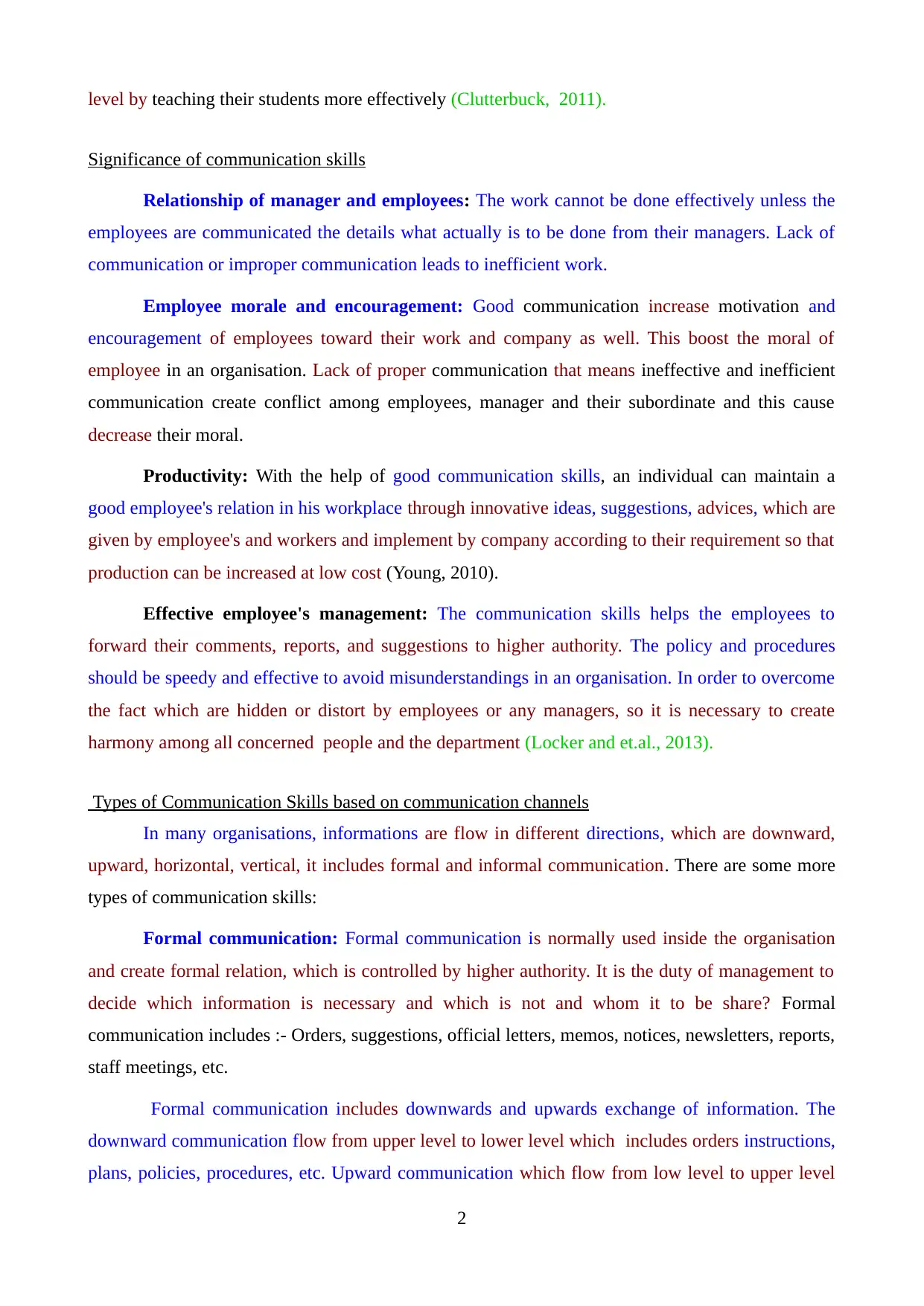
level by teaching their students more effectively (Clutterbuck, 2011).
Significance of communication skills
Relationship of manager and employees: The work cannot be done effectively unless the
employees are communicated the details what actually is to be done from their managers. Lack of
communication or improper communication leads to inefficient work.
Employee morale and encouragement: Good communication increase motivation and
encouragement of employees toward their work and company as well. This boost the moral of
employee in an organisation. Lack of proper communication that means ineffective and inefficient
communication create conflict among employees, manager and their subordinate and this cause
decrease their moral.
Productivity: With the help of good communication skills, an individual can maintain a
good employee's relation in his workplace through innovative ideas, suggestions, advices, which are
given by employee's and workers and implement by company according to their requirement so that
production can be increased at low cost (Young, 2010).
Effective employee's management: The communication skills helps the employees to
forward their comments, reports, and suggestions to higher authority. The policy and procedures
should be speedy and effective to avoid misunderstandings in an organisation. In order to overcome
the fact which are hidden or distort by employees or any managers, so it is necessary to create
harmony among all concerned people and the department (Locker and et.al., 2013).
Types of Communication Skills based on communication channels
In many organisations, informations are flow in different directions, which are downward,
upward, horizontal, vertical, it includes formal and informal communication. There are some more
types of communication skills:
Formal communication: Formal communication is normally used inside the organisation
and create formal relation, which is controlled by higher authority. It is the duty of management to
decide which information is necessary and which is not and whom it to be share? Formal
communication includes :- Orders, suggestions, official letters, memos, notices, newsletters, reports,
staff meetings, etc.
Formal communication includes downwards and upwards exchange of information. The
downward communication flow from upper level to lower level which includes orders instructions,
plans, policies, procedures, etc. Upward communication which flow from low level to upper level
2
Significance of communication skills
Relationship of manager and employees: The work cannot be done effectively unless the
employees are communicated the details what actually is to be done from their managers. Lack of
communication or improper communication leads to inefficient work.
Employee morale and encouragement: Good communication increase motivation and
encouragement of employees toward their work and company as well. This boost the moral of
employee in an organisation. Lack of proper communication that means ineffective and inefficient
communication create conflict among employees, manager and their subordinate and this cause
decrease their moral.
Productivity: With the help of good communication skills, an individual can maintain a
good employee's relation in his workplace through innovative ideas, suggestions, advices, which are
given by employee's and workers and implement by company according to their requirement so that
production can be increased at low cost (Young, 2010).
Effective employee's management: The communication skills helps the employees to
forward their comments, reports, and suggestions to higher authority. The policy and procedures
should be speedy and effective to avoid misunderstandings in an organisation. In order to overcome
the fact which are hidden or distort by employees or any managers, so it is necessary to create
harmony among all concerned people and the department (Locker and et.al., 2013).
Types of Communication Skills based on communication channels
In many organisations, informations are flow in different directions, which are downward,
upward, horizontal, vertical, it includes formal and informal communication. There are some more
types of communication skills:
Formal communication: Formal communication is normally used inside the organisation
and create formal relation, which is controlled by higher authority. It is the duty of management to
decide which information is necessary and which is not and whom it to be share? Formal
communication includes :- Orders, suggestions, official letters, memos, notices, newsletters, reports,
staff meetings, etc.
Formal communication includes downwards and upwards exchange of information. The
downward communication flow from upper level to lower level which includes orders instructions,
plans, policies, procedures, etc. Upward communication which flow from low level to upper level
2
Paraphrase This Document
Need a fresh take? Get an instant paraphrase of this document with our AI Paraphraser
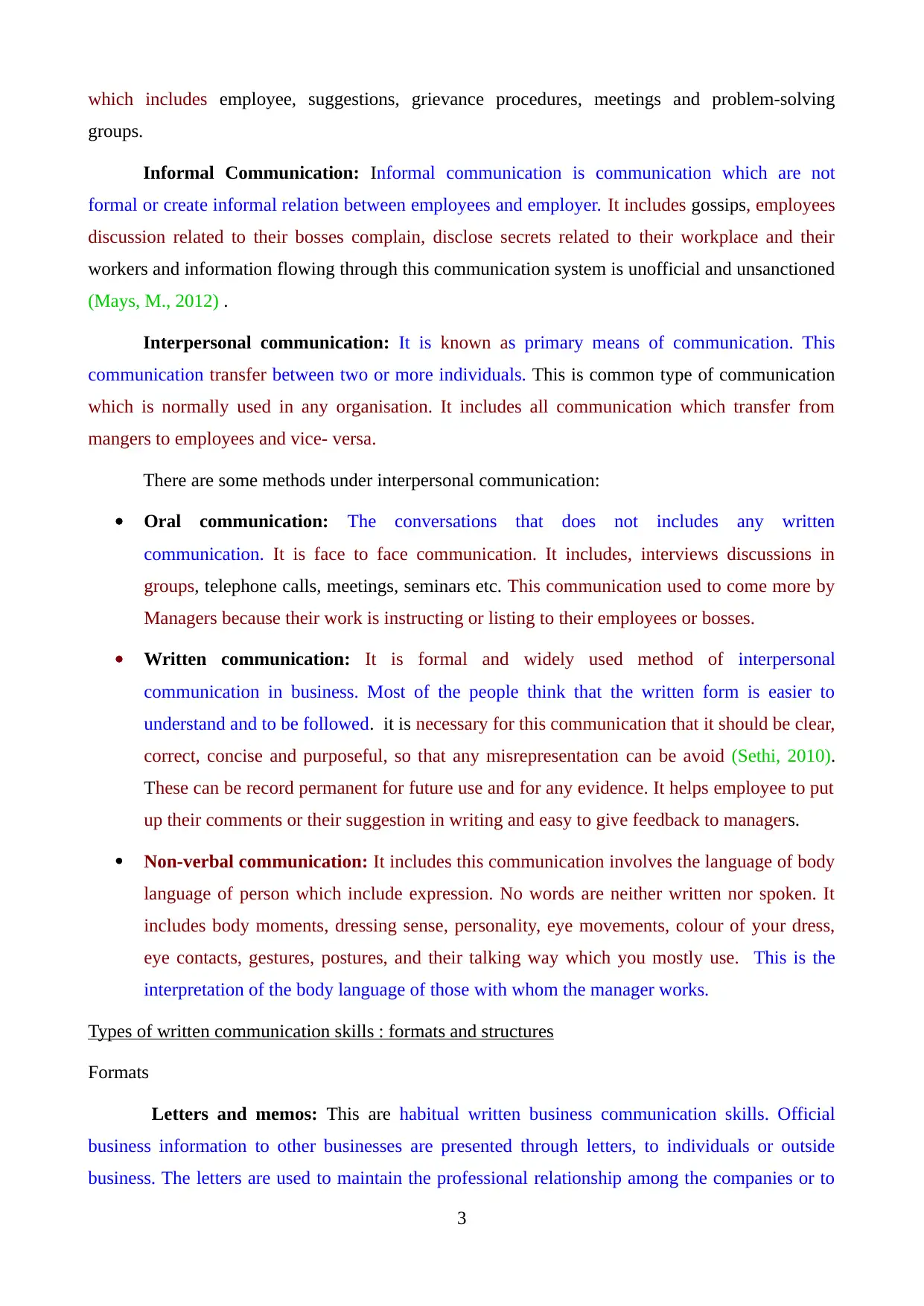
which includes employee, suggestions, grievance procedures, meetings and problem-solving
groups.
Informal Communication: Informal communication is communication which are not
formal or create informal relation between employees and employer. It includes gossips, employees
discussion related to their bosses complain, disclose secrets related to their workplace and their
workers and information flowing through this communication system is unofficial and unsanctioned
(Mays, M., 2012) .
Interpersonal communication: It is known as primary means of communication. This
communication transfer between two or more individuals. This is common type of communication
which is normally used in any organisation. It includes all communication which transfer from
mangers to employees and vice- versa.
There are some methods under interpersonal communication:
Oral communication: The conversations that does not includes any written
communication. It is face to face communication. It includes, interviews discussions in
groups, telephone calls, meetings, seminars etc. This communication used to come more by
Managers because their work is instructing or listing to their employees or bosses.
Written communication: It is formal and widely used method of interpersonal
communication in business. Most of the people think that the written form is easier to
understand and to be followed. it is necessary for this communication that it should be clear,
correct, concise and purposeful, so that any misrepresentation can be avoid (Sethi, 2010).
These can be record permanent for future use and for any evidence. It helps employee to put
up their comments or their suggestion in writing and easy to give feedback to managers.
Non-verbal communication: It includes this communication involves the language of body
language of person which include expression. No words are neither written nor spoken. It
includes body moments, dressing sense, personality, eye movements, colour of your dress,
eye contacts, gestures, postures, and their talking way which you mostly use. This is the
interpretation of the body language of those with whom the manager works.
Types of written communication skills : formats and structures
Formats
Letters and memos: This are habitual written business communication skills. Official
business information to other businesses are presented through letters, to individuals or outside
business. The letters are used to maintain the professional relationship among the companies or to
3
groups.
Informal Communication: Informal communication is communication which are not
formal or create informal relation between employees and employer. It includes gossips, employees
discussion related to their bosses complain, disclose secrets related to their workplace and their
workers and information flowing through this communication system is unofficial and unsanctioned
(Mays, M., 2012) .
Interpersonal communication: It is known as primary means of communication. This
communication transfer between two or more individuals. This is common type of communication
which is normally used in any organisation. It includes all communication which transfer from
mangers to employees and vice- versa.
There are some methods under interpersonal communication:
Oral communication: The conversations that does not includes any written
communication. It is face to face communication. It includes, interviews discussions in
groups, telephone calls, meetings, seminars etc. This communication used to come more by
Managers because their work is instructing or listing to their employees or bosses.
Written communication: It is formal and widely used method of interpersonal
communication in business. Most of the people think that the written form is easier to
understand and to be followed. it is necessary for this communication that it should be clear,
correct, concise and purposeful, so that any misrepresentation can be avoid (Sethi, 2010).
These can be record permanent for future use and for any evidence. It helps employee to put
up their comments or their suggestion in writing and easy to give feedback to managers.
Non-verbal communication: It includes this communication involves the language of body
language of person which include expression. No words are neither written nor spoken. It
includes body moments, dressing sense, personality, eye movements, colour of your dress,
eye contacts, gestures, postures, and their talking way which you mostly use. This is the
interpretation of the body language of those with whom the manager works.
Types of written communication skills : formats and structures
Formats
Letters and memos: This are habitual written business communication skills. Official
business information to other businesses are presented through letters, to individuals or outside
business. The letters are used to maintain the professional relationship among the companies or to
3
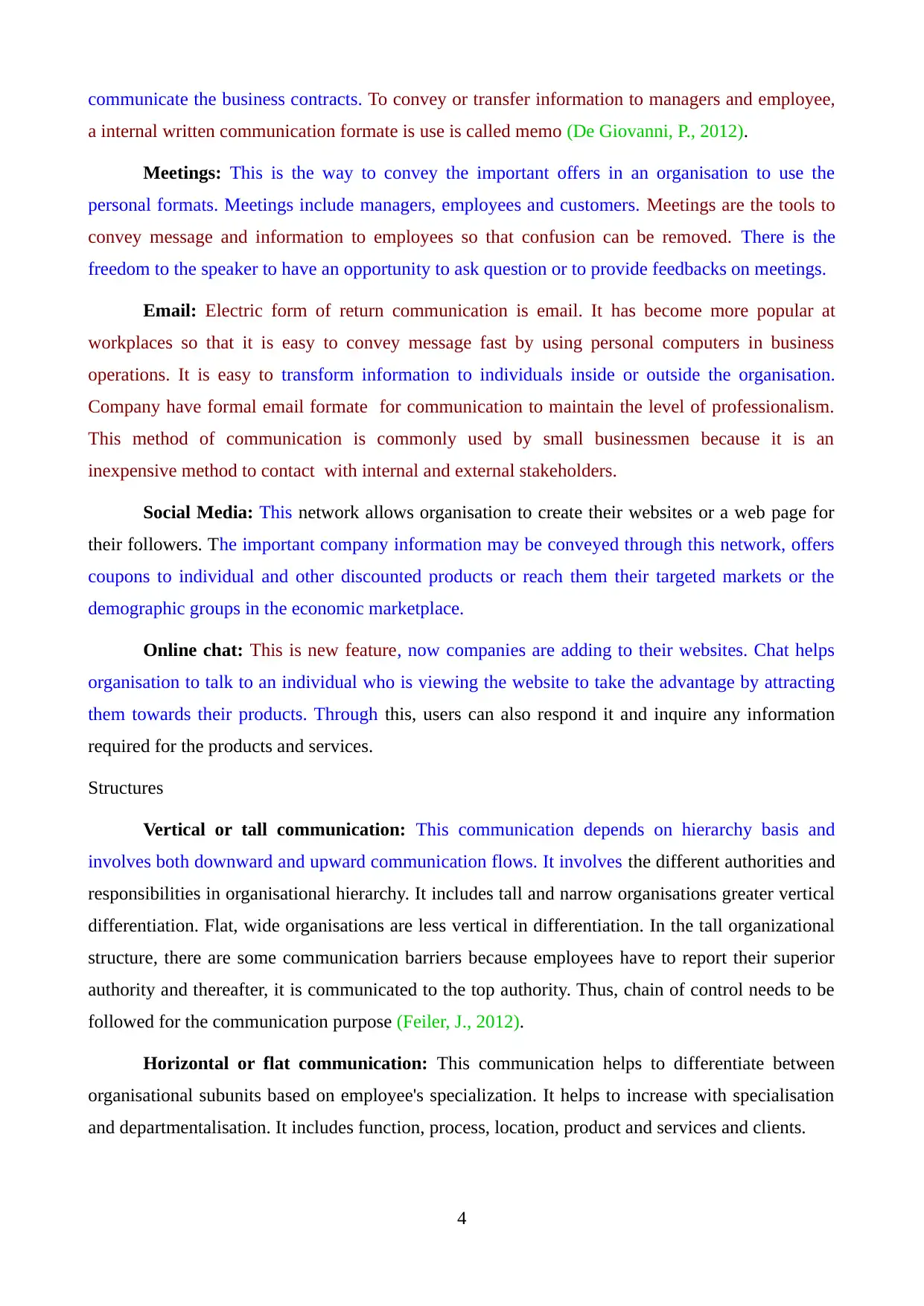
communicate the business contracts. To convey or transfer information to managers and employee,
a internal written communication formate is use is called memo (De Giovanni, P., 2012).
Meetings: This is the way to convey the important offers in an organisation to use the
personal formats. Meetings include managers, employees and customers. Meetings are the tools to
convey message and information to employees so that confusion can be removed. There is the
freedom to the speaker to have an opportunity to ask question or to provide feedbacks on meetings.
Email: Electric form of return communication is email. It has become more popular at
workplaces so that it is easy to convey message fast by using personal computers in business
operations. It is easy to transform information to individuals inside or outside the organisation.
Company have formal email formate for communication to maintain the level of professionalism.
This method of communication is commonly used by small businessmen because it is an
inexpensive method to contact with internal and external stakeholders.
Social Media: This network allows organisation to create their websites or a web page for
their followers. The important company information may be conveyed through this network, offers
coupons to individual and other discounted products or reach them their targeted markets or the
demographic groups in the economic marketplace.
Online chat: This is new feature, now companies are adding to their websites. Chat helps
organisation to talk to an individual who is viewing the website to take the advantage by attracting
them towards their products. Through this, users can also respond it and inquire any information
required for the products and services.
Structures
Vertical or tall communication: This communication depends on hierarchy basis and
involves both downward and upward communication flows. It involves the different authorities and
responsibilities in organisational hierarchy. It includes tall and narrow organisations greater vertical
differentiation. Flat, wide organisations are less vertical in differentiation. In the tall organizational
structure, there are some communication barriers because employees have to report their superior
authority and thereafter, it is communicated to the top authority. Thus, chain of control needs to be
followed for the communication purpose (Feiler, J., 2012).
Horizontal or flat communication: This communication helps to differentiate between
organisational subunits based on employee's specialization. It helps to increase with specialisation
and departmentalisation. It includes function, process, location, product and services and clients.
4
a internal written communication formate is use is called memo (De Giovanni, P., 2012).
Meetings: This is the way to convey the important offers in an organisation to use the
personal formats. Meetings include managers, employees and customers. Meetings are the tools to
convey message and information to employees so that confusion can be removed. There is the
freedom to the speaker to have an opportunity to ask question or to provide feedbacks on meetings.
Email: Electric form of return communication is email. It has become more popular at
workplaces so that it is easy to convey message fast by using personal computers in business
operations. It is easy to transform information to individuals inside or outside the organisation.
Company have formal email formate for communication to maintain the level of professionalism.
This method of communication is commonly used by small businessmen because it is an
inexpensive method to contact with internal and external stakeholders.
Social Media: This network allows organisation to create their websites or a web page for
their followers. The important company information may be conveyed through this network, offers
coupons to individual and other discounted products or reach them their targeted markets or the
demographic groups in the economic marketplace.
Online chat: This is new feature, now companies are adding to their websites. Chat helps
organisation to talk to an individual who is viewing the website to take the advantage by attracting
them towards their products. Through this, users can also respond it and inquire any information
required for the products and services.
Structures
Vertical or tall communication: This communication depends on hierarchy basis and
involves both downward and upward communication flows. It involves the different authorities and
responsibilities in organisational hierarchy. It includes tall and narrow organisations greater vertical
differentiation. Flat, wide organisations are less vertical in differentiation. In the tall organizational
structure, there are some communication barriers because employees have to report their superior
authority and thereafter, it is communicated to the top authority. Thus, chain of control needs to be
followed for the communication purpose (Feiler, J., 2012).
Horizontal or flat communication: This communication helps to differentiate between
organisational subunits based on employee's specialization. It helps to increase with specialisation
and departmentalisation. It includes function, process, location, product and services and clients.
4
⊘ This is a preview!⊘
Do you want full access?
Subscribe today to unlock all pages.

Trusted by 1+ million students worldwide
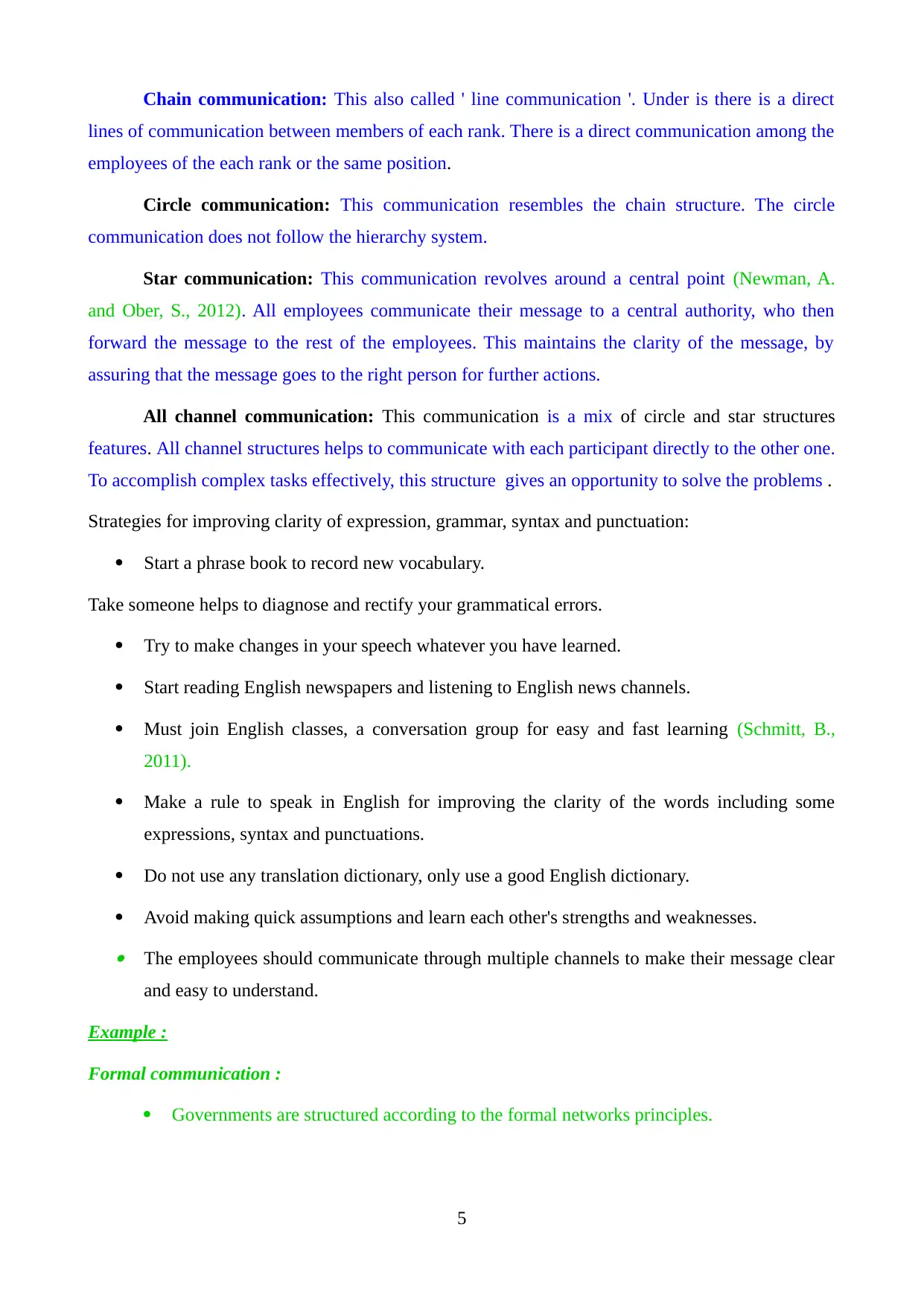
Chain communication: This also called ' line communication '. Under is there is a direct
lines of communication between members of each rank. There is a direct communication among the
employees of the each rank or the same position.
Circle communication: This communication resembles the chain structure. The circle
communication does not follow the hierarchy system.
Star communication: This communication revolves around a central point (Newman, A.
and Ober, S., 2012). All employees communicate their message to a central authority, who then
forward the message to the rest of the employees. This maintains the clarity of the message, by
assuring that the message goes to the right person for further actions.
All channel communication: This communication is a mix of circle and star structures
features. All channel structures helps to communicate with each participant directly to the other one.
To accomplish complex tasks effectively, this structure gives an opportunity to solve the problems .
Strategies for improving clarity of expression, grammar, syntax and punctuation:
Start a phrase book to record new vocabulary.
Take someone helps to diagnose and rectify your grammatical errors.
Try to make changes in your speech whatever you have learned.
Start reading English newspapers and listening to English news channels.
Must join English classes, a conversation group for easy and fast learning (Schmitt, B.,
2011).
Make a rule to speak in English for improving the clarity of the words including some
expressions, syntax and punctuations.
Do not use any translation dictionary, only use a good English dictionary.
Avoid making quick assumptions and learn each other's strengths and weaknesses.
The employees should communicate through multiple channels to make their message clear
and easy to understand.
Example :
Formal communication :
Governments are structured according to the formal networks principles.
5
lines of communication between members of each rank. There is a direct communication among the
employees of the each rank or the same position.
Circle communication: This communication resembles the chain structure. The circle
communication does not follow the hierarchy system.
Star communication: This communication revolves around a central point (Newman, A.
and Ober, S., 2012). All employees communicate their message to a central authority, who then
forward the message to the rest of the employees. This maintains the clarity of the message, by
assuring that the message goes to the right person for further actions.
All channel communication: This communication is a mix of circle and star structures
features. All channel structures helps to communicate with each participant directly to the other one.
To accomplish complex tasks effectively, this structure gives an opportunity to solve the problems .
Strategies for improving clarity of expression, grammar, syntax and punctuation:
Start a phrase book to record new vocabulary.
Take someone helps to diagnose and rectify your grammatical errors.
Try to make changes in your speech whatever you have learned.
Start reading English newspapers and listening to English news channels.
Must join English classes, a conversation group for easy and fast learning (Schmitt, B.,
2011).
Make a rule to speak in English for improving the clarity of the words including some
expressions, syntax and punctuations.
Do not use any translation dictionary, only use a good English dictionary.
Avoid making quick assumptions and learn each other's strengths and weaknesses.
The employees should communicate through multiple channels to make their message clear
and easy to understand.
Example :
Formal communication :
Governments are structured according to the formal networks principles.
5
Paraphrase This Document
Need a fresh take? Get an instant paraphrase of this document with our AI Paraphraser
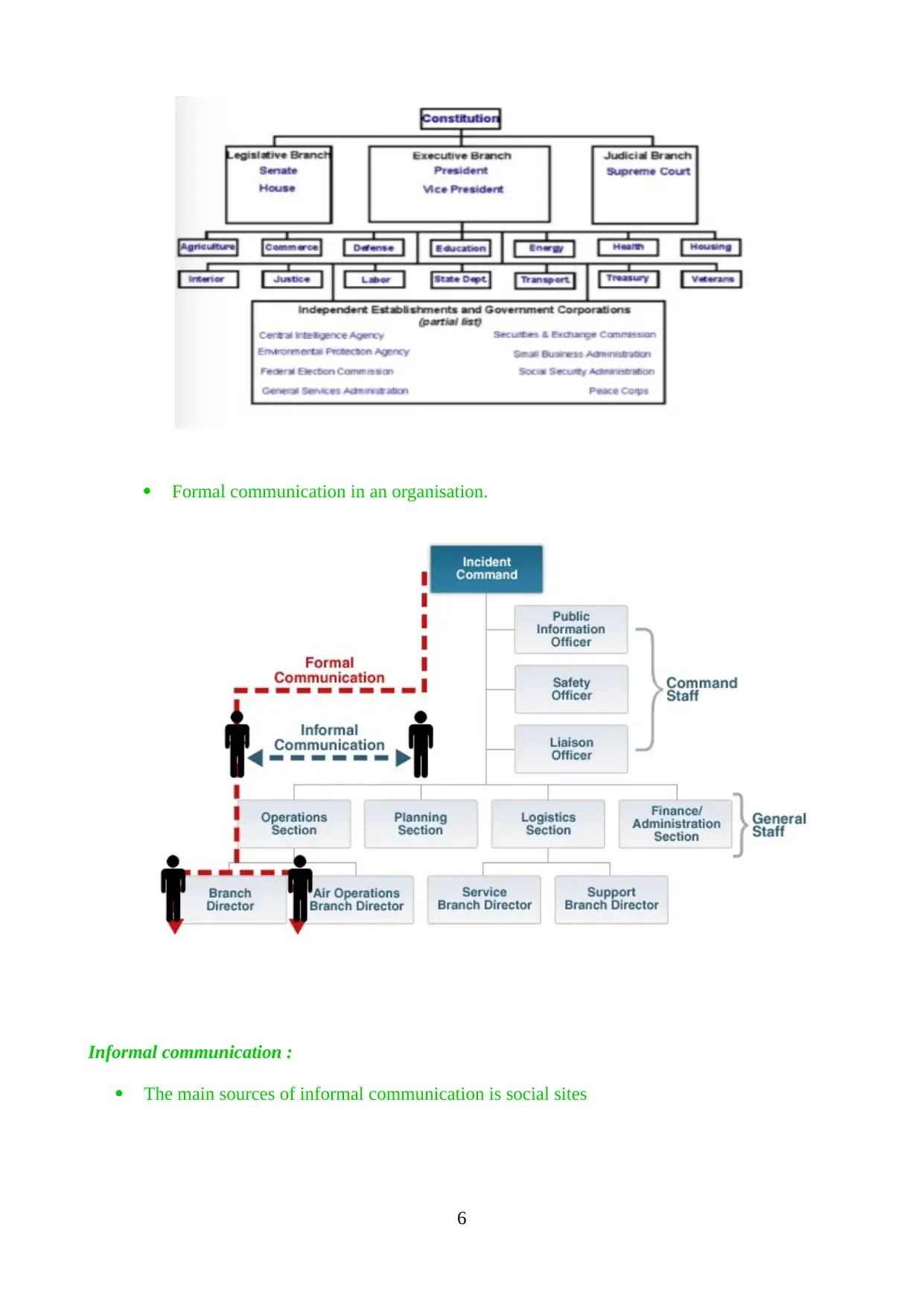
Formal communication in an organisation.
Informal communication :
The main sources of informal communication is social sites
6
Informal communication :
The main sources of informal communication is social sites
6
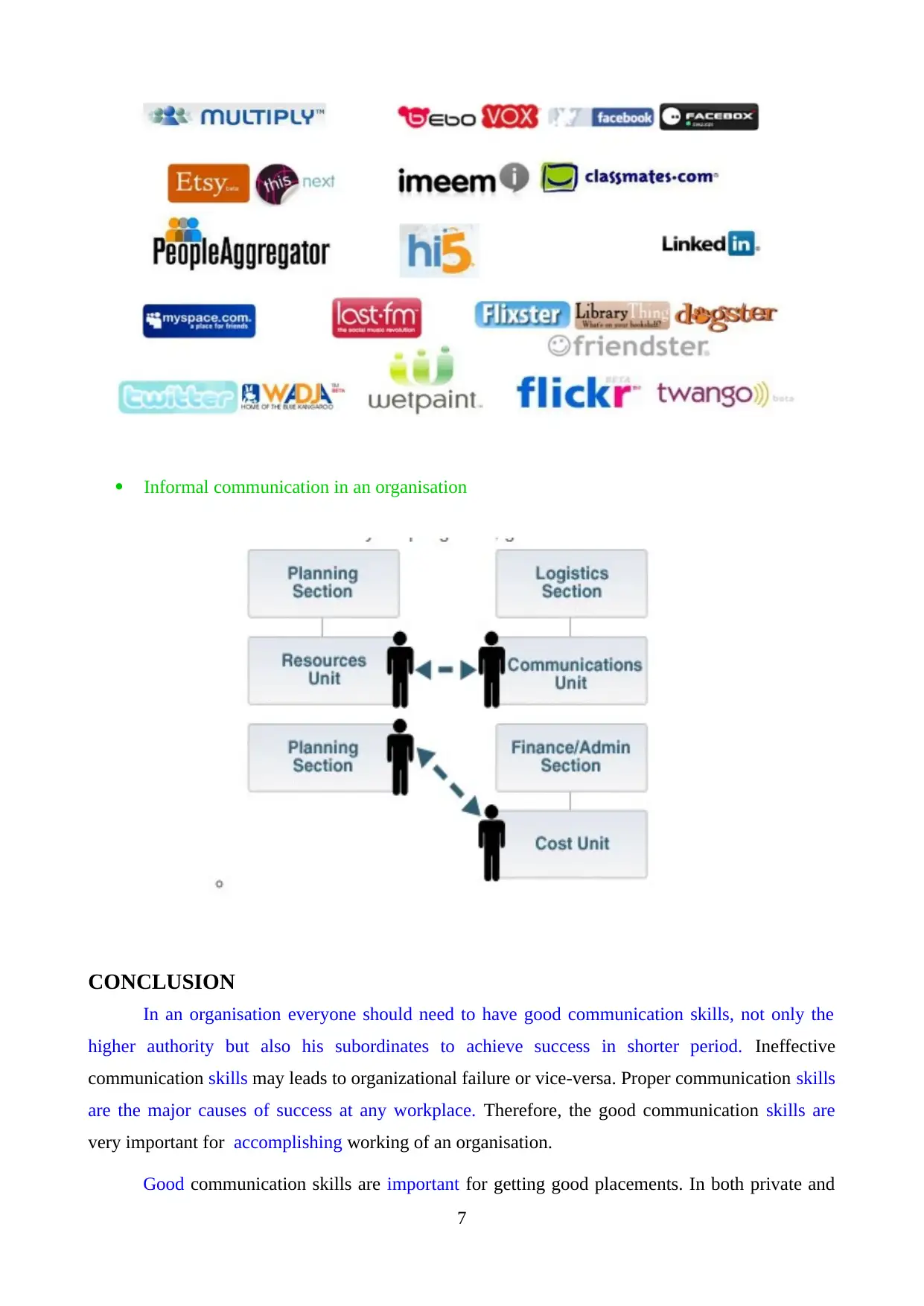
Informal communication in an organisation
CONCLUSION
In an organisation everyone should need to have good communication skills, not only the
higher authority but also his subordinates to achieve success in shorter period. Ineffective
communication skills may leads to organizational failure or vice-versa. Proper communication skills
are the major causes of success at any workplace. Therefore, the good communication skills are
very important for accomplishing working of an organisation.
Good communication skills are important for getting good placements. In both private and
7
CONCLUSION
In an organisation everyone should need to have good communication skills, not only the
higher authority but also his subordinates to achieve success in shorter period. Ineffective
communication skills may leads to organizational failure or vice-versa. Proper communication skills
are the major causes of success at any workplace. Therefore, the good communication skills are
very important for accomplishing working of an organisation.
Good communication skills are important for getting good placements. In both private and
7
⊘ This is a preview!⊘
Do you want full access?
Subscribe today to unlock all pages.

Trusted by 1+ million students worldwide
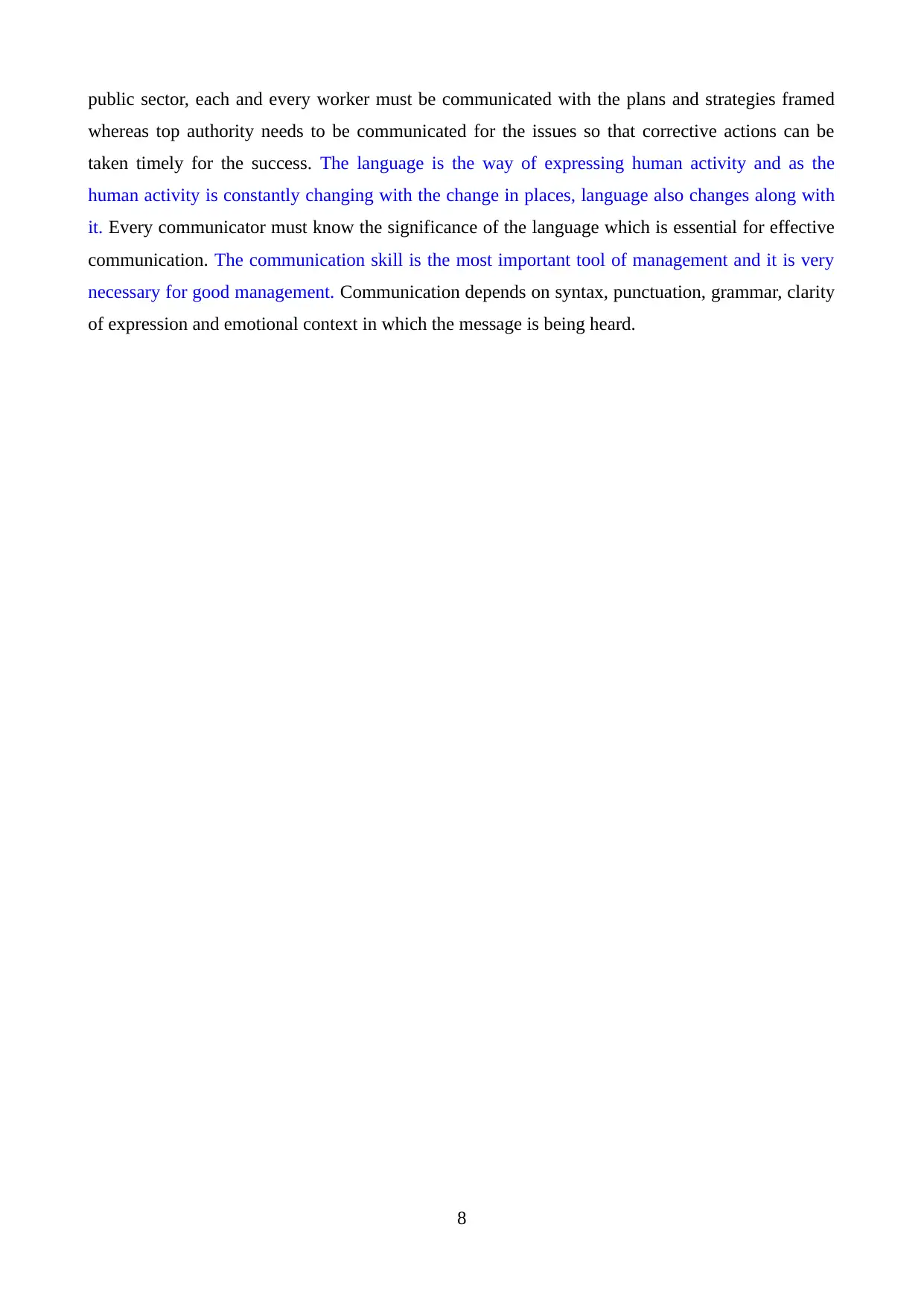
public sector, each and every worker must be communicated with the plans and strategies framed
whereas top authority needs to be communicated for the issues so that corrective actions can be
taken timely for the success. The language is the way of expressing human activity and as the
human activity is constantly changing with the change in places, language also changes along with
it. Every communicator must know the significance of the language which is essential for effective
communication. The communication skill is the most important tool of management and it is very
necessary for good management. Communication depends on syntax, punctuation, grammar, clarity
of expression and emotional context in which the message is being heard.
8
whereas top authority needs to be communicated for the issues so that corrective actions can be
taken timely for the success. The language is the way of expressing human activity and as the
human activity is constantly changing with the change in places, language also changes along with
it. Every communicator must know the significance of the language which is essential for effective
communication. The communication skill is the most important tool of management and it is very
necessary for good management. Communication depends on syntax, punctuation, grammar, clarity
of expression and emotional context in which the message is being heard.
8
Paraphrase This Document
Need a fresh take? Get an instant paraphrase of this document with our AI Paraphraser
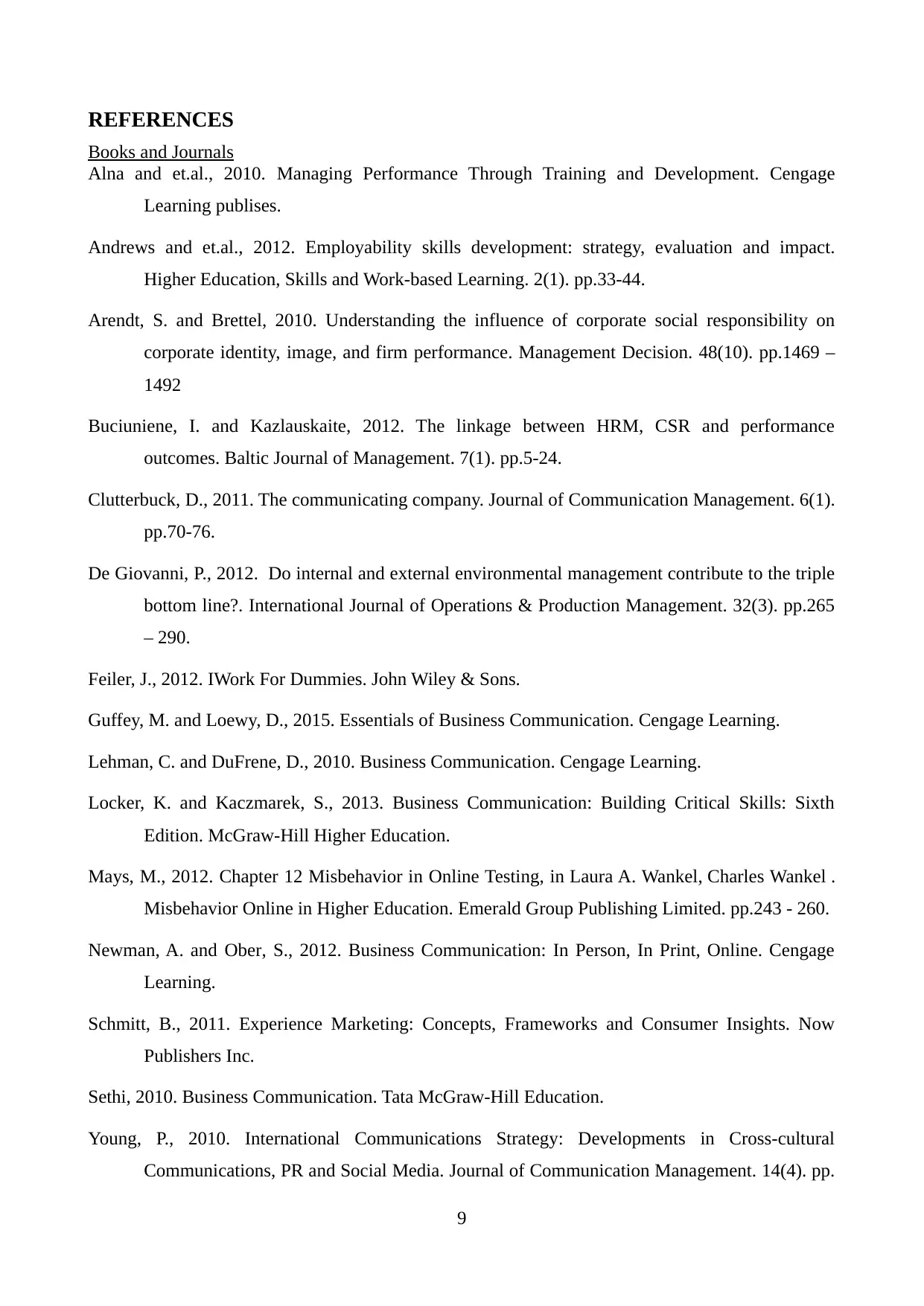
REFERENCES
Books and Journals
Alna and et.al., 2010. Managing Performance Through Training and Development. Cengage
Learning publises.
Andrews and et.al., 2012. Employability skills development: strategy, evaluation and impact.
Higher Education, Skills and Work-based Learning. 2(1). pp.33-44.
Arendt, S. and Brettel, 2010. Understanding the influence of corporate social responsibility on
corporate identity, image, and firm performance. Management Decision. 48(10). pp.1469 –
1492
Buciuniene, I. and Kazlauskaite, 2012. The linkage between HRM, CSR and performance
outcomes. Baltic Journal of Management. 7(1). pp.5-24.
Clutterbuck, D., 2011. The communicating company. Journal of Communication Management. 6(1).
pp.70-76.
De Giovanni, P., 2012. Do internal and external environmental management contribute to the triple
bottom line?. International Journal of Operations & Production Management. 32(3). pp.265
– 290.
Feiler, J., 2012. IWork For Dummies. John Wiley & Sons.
Guffey, M. and Loewy, D., 2015. Essentials of Business Communication. Cengage Learning.
Lehman, C. and DuFrene, D., 2010. Business Communication. Cengage Learning.
Locker, K. and Kaczmarek, S., 2013. Business Communication: Building Critical Skills: Sixth
Edition. McGraw-Hill Higher Education.
Mays, M., 2012. Chapter 12 Misbehavior in Online Testing, in Laura A. Wankel, Charles Wankel .
Misbehavior Online in Higher Education. Emerald Group Publishing Limited. pp.243 - 260.
Newman, A. and Ober, S., 2012. Business Communication: In Person, In Print, Online. Cengage
Learning.
Schmitt, B., 2011. Experience Marketing: Concepts, Frameworks and Consumer Insights. Now
Publishers Inc.
Sethi, 2010. Business Communication. Tata McGraw-Hill Education.
Young, P., 2010. International Communications Strategy: Developments in Cross‐cultural
Communications, PR and Social Media. Journal of Communication Management. 14(4). pp.
9
Books and Journals
Alna and et.al., 2010. Managing Performance Through Training and Development. Cengage
Learning publises.
Andrews and et.al., 2012. Employability skills development: strategy, evaluation and impact.
Higher Education, Skills and Work-based Learning. 2(1). pp.33-44.
Arendt, S. and Brettel, 2010. Understanding the influence of corporate social responsibility on
corporate identity, image, and firm performance. Management Decision. 48(10). pp.1469 –
1492
Buciuniene, I. and Kazlauskaite, 2012. The linkage between HRM, CSR and performance
outcomes. Baltic Journal of Management. 7(1). pp.5-24.
Clutterbuck, D., 2011. The communicating company. Journal of Communication Management. 6(1).
pp.70-76.
De Giovanni, P., 2012. Do internal and external environmental management contribute to the triple
bottom line?. International Journal of Operations & Production Management. 32(3). pp.265
– 290.
Feiler, J., 2012. IWork For Dummies. John Wiley & Sons.
Guffey, M. and Loewy, D., 2015. Essentials of Business Communication. Cengage Learning.
Lehman, C. and DuFrene, D., 2010. Business Communication. Cengage Learning.
Locker, K. and Kaczmarek, S., 2013. Business Communication: Building Critical Skills: Sixth
Edition. McGraw-Hill Higher Education.
Mays, M., 2012. Chapter 12 Misbehavior in Online Testing, in Laura A. Wankel, Charles Wankel .
Misbehavior Online in Higher Education. Emerald Group Publishing Limited. pp.243 - 260.
Newman, A. and Ober, S., 2012. Business Communication: In Person, In Print, Online. Cengage
Learning.
Schmitt, B., 2011. Experience Marketing: Concepts, Frameworks and Consumer Insights. Now
Publishers Inc.
Sethi, 2010. Business Communication. Tata McGraw-Hill Education.
Young, P., 2010. International Communications Strategy: Developments in Cross‐cultural
Communications, PR and Social Media. Journal of Communication Management. 14(4). pp.
9
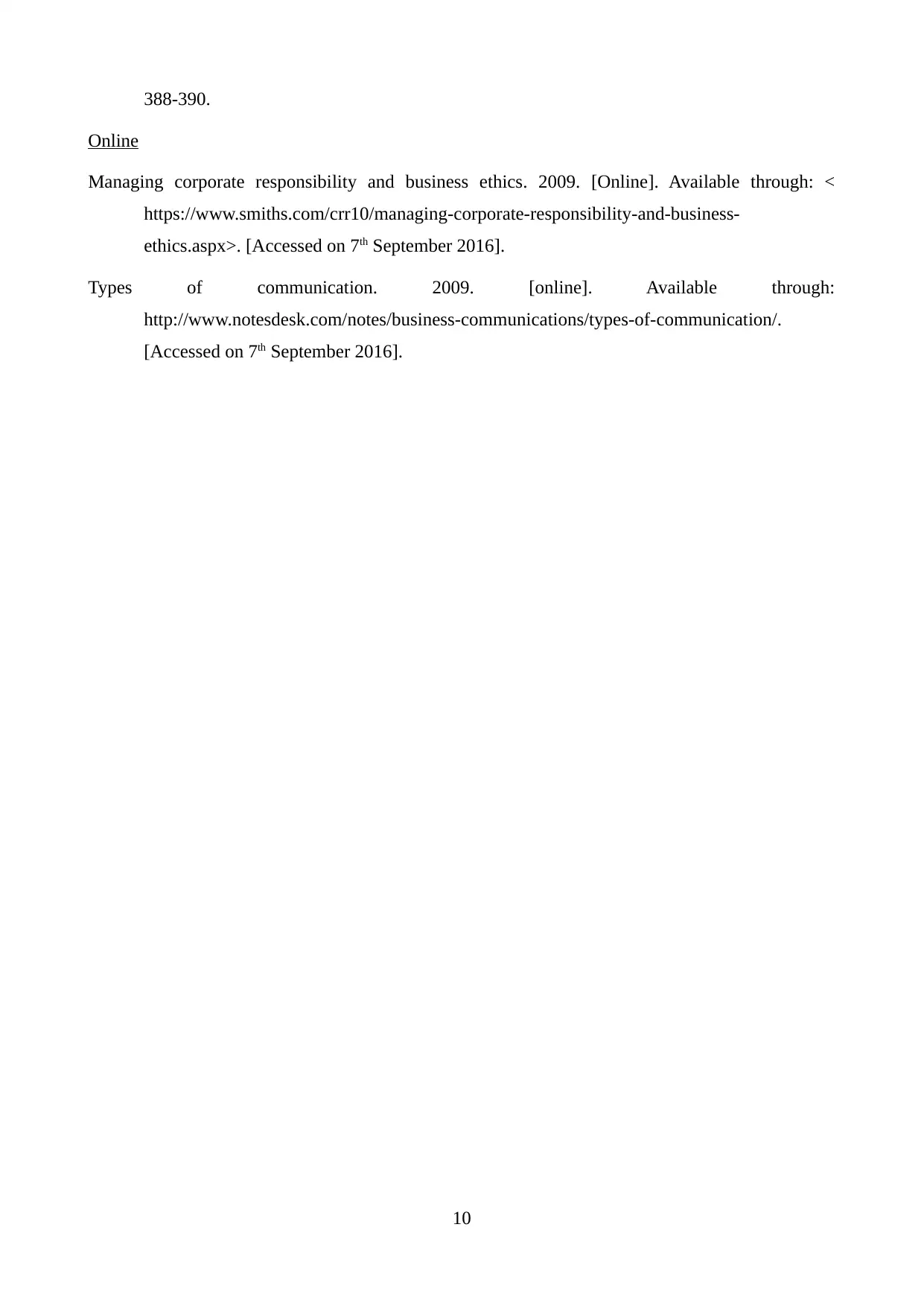
388-390.
Online
Managing corporate responsibility and business ethics. 2009. [Online]. Available through: <
https://www.smiths.com/crr10/managing-corporate-responsibility-and-business-
ethics.aspx>. [Accessed on 7th September 2016].
Types of communication. 2009. [online]. Available through:
http://www.notesdesk.com/notes/business-communications/types-of-communication/.
[Accessed on 7th September 2016].
10
Online
Managing corporate responsibility and business ethics. 2009. [Online]. Available through: <
https://www.smiths.com/crr10/managing-corporate-responsibility-and-business-
ethics.aspx>. [Accessed on 7th September 2016].
Types of communication. 2009. [online]. Available through:
http://www.notesdesk.com/notes/business-communications/types-of-communication/.
[Accessed on 7th September 2016].
10
⊘ This is a preview!⊘
Do you want full access?
Subscribe today to unlock all pages.

Trusted by 1+ million students worldwide
1 out of 12
Related Documents
Your All-in-One AI-Powered Toolkit for Academic Success.
+13062052269
info@desklib.com
Available 24*7 on WhatsApp / Email
![[object Object]](/_next/static/media/star-bottom.7253800d.svg)
Unlock your academic potential
Copyright © 2020–2025 A2Z Services. All Rights Reserved. Developed and managed by ZUCOL.




